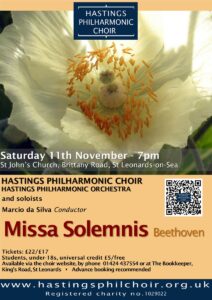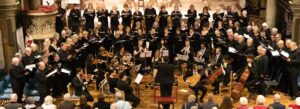
Beethoven Mass in D Major – Missa Solemnis Op 123
St John’s Church Hastings Saturday 11th November 2023
Hastings Philharmonic Choir and Orchestra
Conductor: Marco d Silva
Soloists:
Helen May Soprano
Marta Fontanals-Simmons Contralto
Leonel Pinheiro Tenor
Edwin Kaye Bass
The Missa Solemnis is a monumental work. It was composed slowly durin Beethoven’s final decade, and has inevitably been compared to the ground-breaking 9th Symphony or late quartets. Vincent D’Indy wrote that “We stand in the presence of one of the greatest masterworks in the realm of music”. One critic has suggested that it is ‘a work so intense, heartfelt and original that it nearly defies categorization’ while another felt that ‘to those for whom Beethoven’s music is an important reason for living, the Missa Solemnis belongs at the centre of their experience – a work to respect, certainly, but still more to love.’
Once described as ‘ the greatest work never heard’, the Mass is not performed that often, particularly by non-professional musicians who are perhaps discouraged by the apparent need for vast forces and the relentless musical demands. More credit then to Marcio da Silva and the Hastings Philharmonic Choir and Orchestra for rising so brilliantly to the challenge and producing a superb performance. A choir of around 60 and an orchestra of 34 provided an insight into the subtleties and details of the work often concealed by more gargantuan performances, which can be dominated by rhythmic inflexibility and ‘can belto’ singing throughout.
The four soloists sang with great poise and immaculate tuning; in a work where there are few opportunities for individual vocal bravura, they demonstrated precise and sensitive ensemble singing, especially in softer, more serene moments, with a particularly fine performances by soprano Helen May and tenor Leonel Pinheiro, well supported by Marta Fontanals-Simmons and Edwin Kaye, both of whom adopted a more gentle approach to their parts. The balance between soloists, choir and orchestra was also masterful and says much for the conductor’s control of his forces, with the solo voices often floating out from the mass of orchestral and vocal sound.
The richness of the orchestral playing was evident from the very start of the Kyrie, supporting both lyrical and dramatic, at times even forceful singing from both soloists and choir: throughout the performance, high entries and top B-flats were executed in an effortless way by the choir, without any signs of strain and showing a real purity of tone. Mario da Silva likes fast tempi, and the opening of the Gloria was thrilling; I liked his ability to reflect the almost Brahmsian rhythmic ambivalence in a work which can too easily be dominated by a strict adherence to time signatures (particularly the repeated use of 3/4). The orchestra and choir also managed difficult runs with real expertise, while the fugue at the end of the Gloria was dramatic in its treatment of the musical themes. Occasionally, the orchestra, small as it was, was a little overwhelming (possibly a result of the generous acoustic of St John’s Church) and I did feel that there was some lack of tonal variety – but this may well be inherent in the writing. That said, the string and brass playing was beautifully controlled, while the woodwind interjections and ensemble sections added to the overall colour. The Credo provided more variety in textures, with some sublimely lyrical singing by the soloists and the rapid modulations in certain parts were handled in a relaxed way. Fast passages for choir and orchestra showed remarkable discipline and control, while the timpani part throughout the work added to the drama and climaxes.
The adagio section for the soloists at the start of the Sanctus had a relaxed intensity about it, while the choir tackled the speedy allegro with excellent articulation in the semi-quaver runs, with real drama in the final Osanna. There was a little uncertainty with the chromatic harmonies of the orchestral Preludium, but this was more than compensated for by the exquisite violin solo in the Benedictus, one of the high points of the performance, balanced by the calm and unforced solo bass of Edwin Kaye. The choir and soloists responded well to the variety of pace and the harmonic complexities of the Agnus Dei, leading to some thrilling climaxes and the surprisingly calm, almost abrupt ending – and there were few signs that they choir had tired at all, relentlessly demanding as the work is.
A large audience almost filling the Church was able to appreciate a fine realisation of this demanding but somewhat puzzling work. All those involved showed the utmost musicality and Marcio de Silva and his choir and orchestra are to be congratulated on such an impressive performance which highlighted not only the grandeur of the work, but its overall form, structure and detail. 